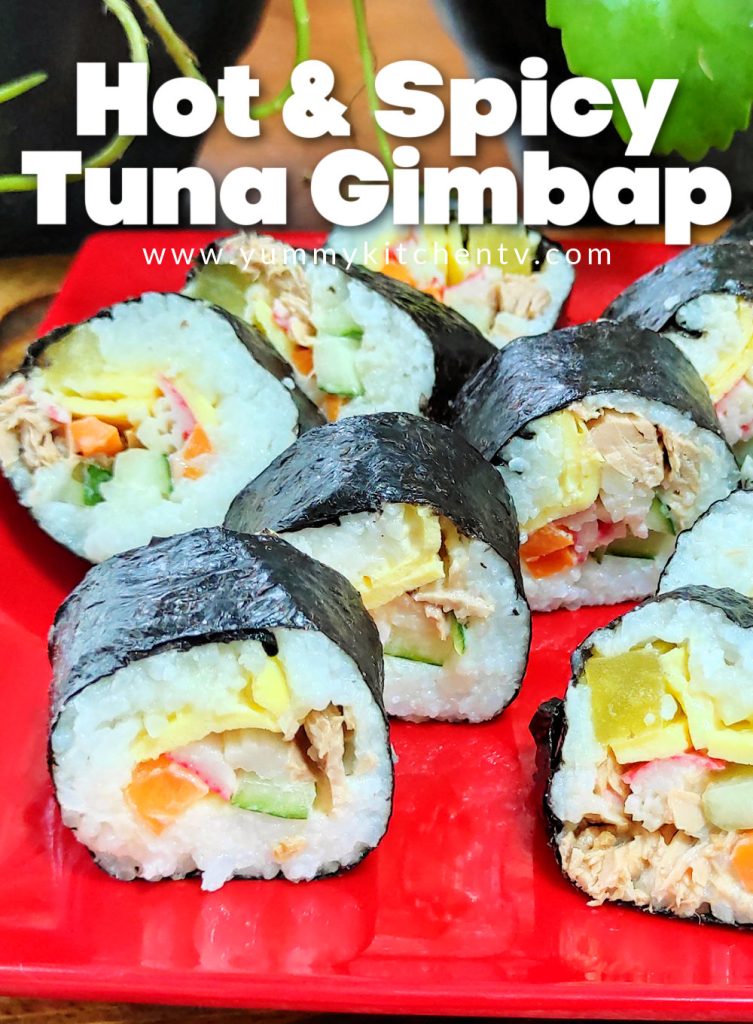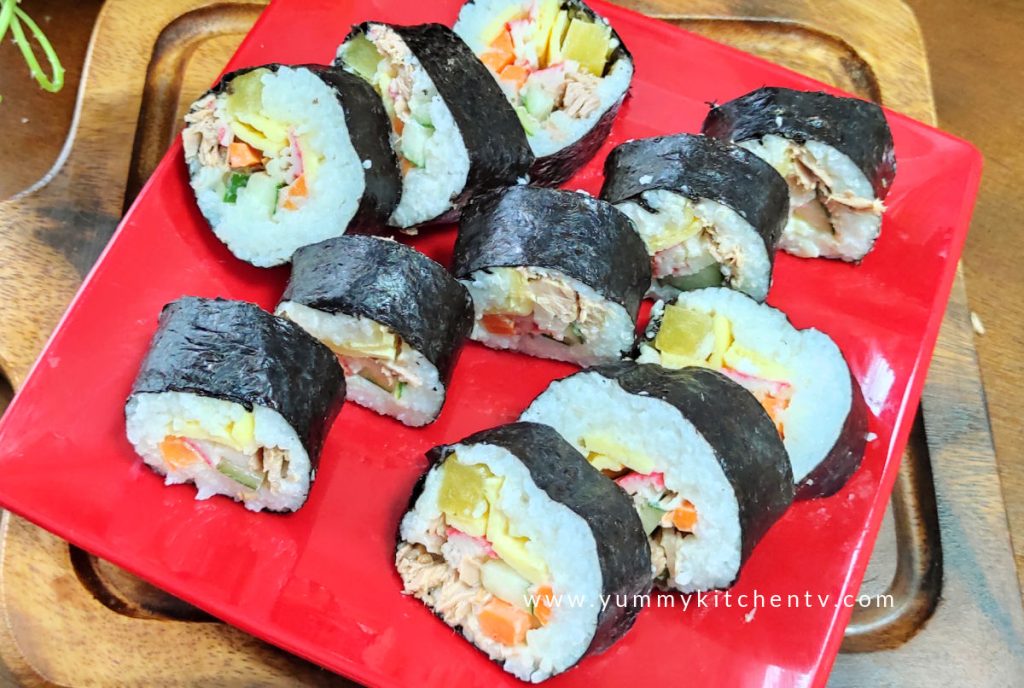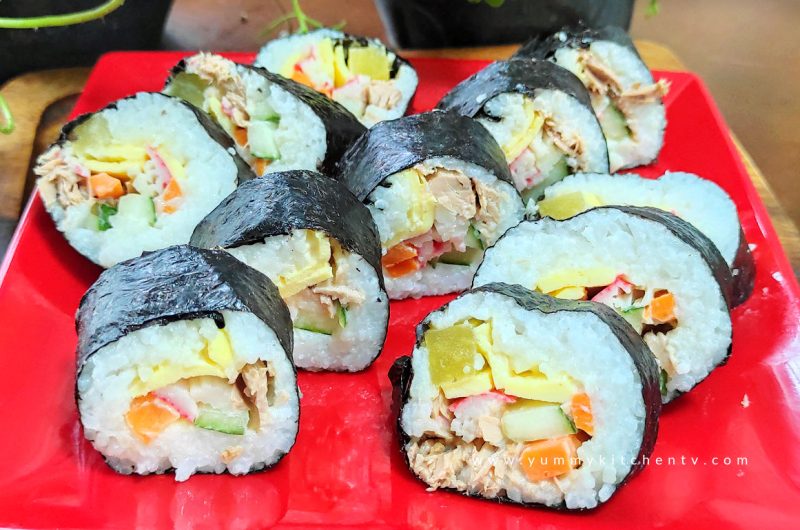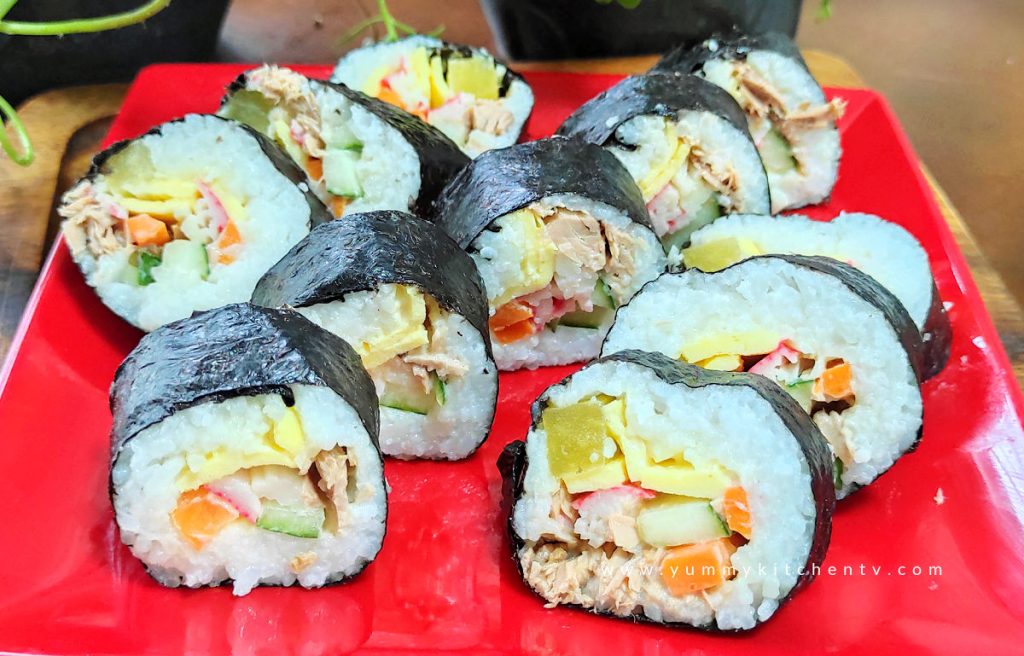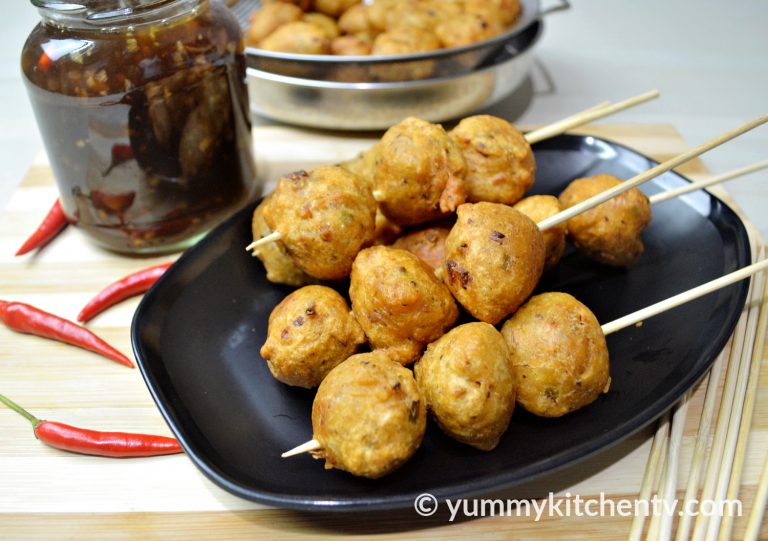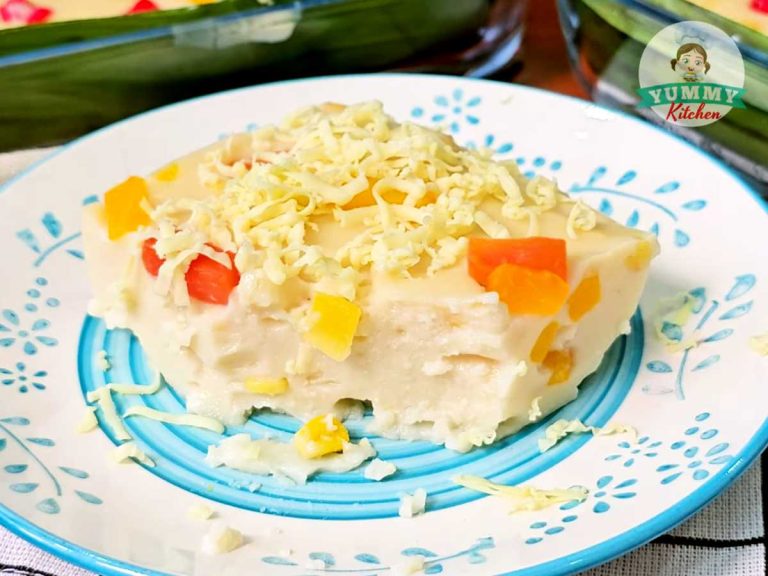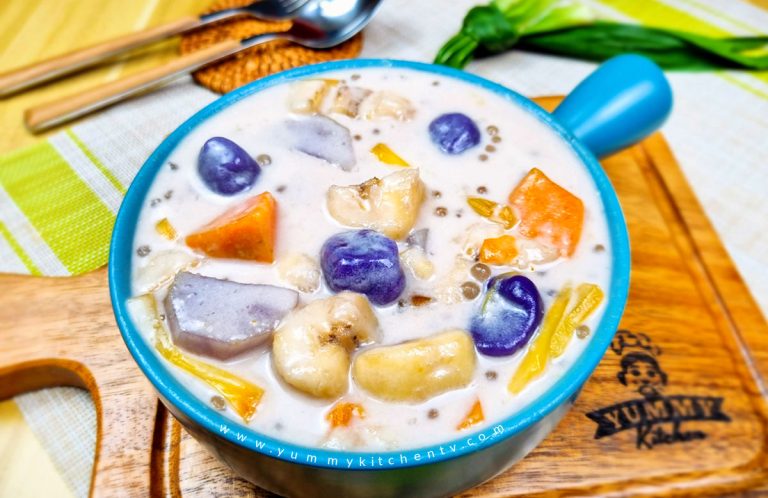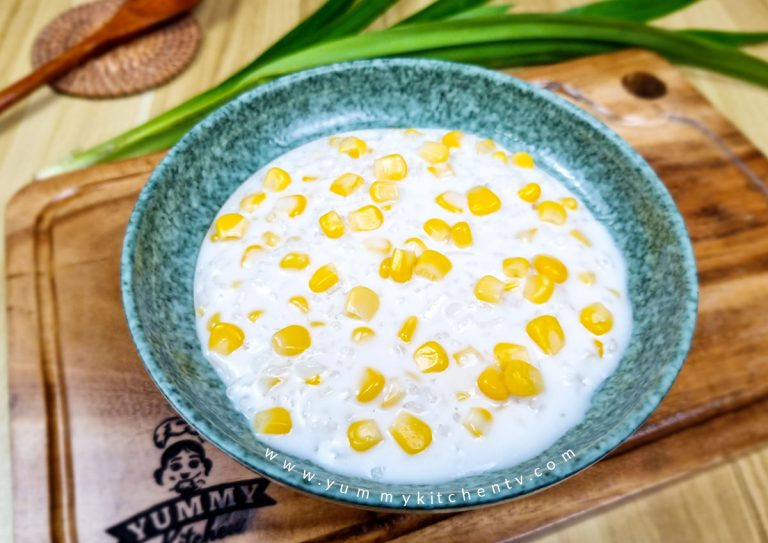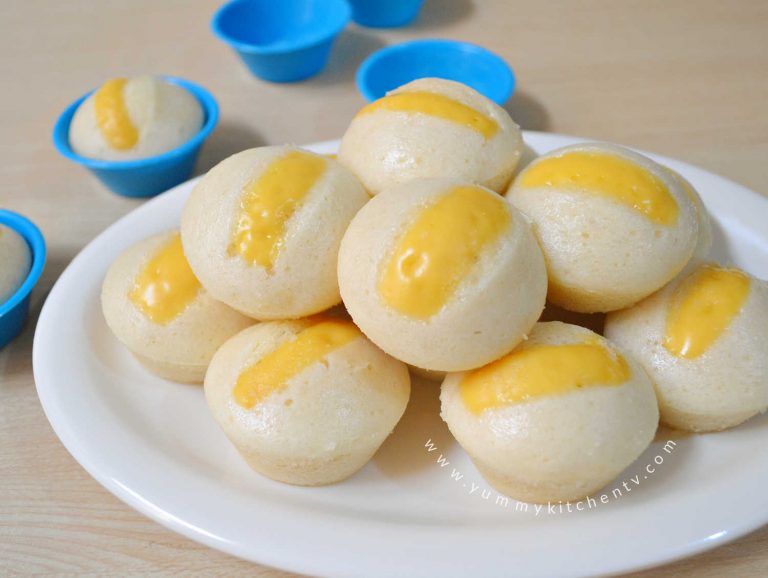Tuna Kimbap
Tuna Kimbap is a wrap filled with rice, spicy tuna, pickled radish, crab sticks, carrots, cucumber, egg, japanese mayo and sesame then wrapped in nori sheet! If you are looking for a perfect snack to share among your k-buddies, having some quick filling bites of this spicy tuna kimbap will surely hype up your kdrama night!
HOT AND SPICY TUNA KIMBAP RECIPE
Ingredients:
- 1 cup rice
- 1 tablespoon vinegar
- ¼ teaspoon salt
- 1 can century tuna
- 3 pieces pickled radish
- 1 egg
- ¼ cucumber
- 1 small carrot
- Nori sheet
- Crab sticks
- Japanese mayo
- Sesame oil
Directions:
- Wash and then cook your rice. When cooked, add the vinegar, salt and sesame oil. Mix until well combined.
- Drain the canned tuna and transfer in a bowl. Prepare the pickled radish and crab sticks. Slice the carrots and cucumber into long strips. Set aside. Crack an egg in a bowl and then whisk.
- Heat some sesame oil in a pan and then pour the beaten egg. Cook and flip to cook the other side. Set aside.
- In the same pan, add the carrot strips and cook for a few minutes. Add the crab sticks and cook for a minute. Set aside. Slice the egg into thin strips. Set aside.
- Prepare the rolling mat and lay it on a flat surface. Add a sheet of nori and then scoop a portion of rice. Spread it evenly all over the nori sheet, leaving about 1 to 2 inches on every side exposed.
- Drizzle some japanese mayo and then arrange the fillings. Roll the bamboo mat up and away carefully. Slice the gimbap into 12 thick rolls.
- Transfer the hot and spicy tuna gimbap to a serving plate. Grab your chopsticks and enjoy the gimbap. Yum!
WHAT IS KIMBAP
If you haven’t heard about what gimbap is, then this snack will truly amaze you.
Gimbap or Kimbap, is a Korean dish made with boiled rice, veggies and your chosen meat, all rolled and wrapped inside of a “gim” or nori sheet. The name of this dish came from the “gim/kim” meaning nori, and “bap”, or “cooked rice”. Looking at the dish, you can easily see the seaweed sheet coating the whole thing and then the rice inside it which holds the other fillings.
For some, gimbap is the Korean version of the world famous Japanese sushi. The concept of making a sushi is to have a quick bite with everything inside it. It is more often than not that people compare the gimbap with the sushi. Their difference lies in the rice and the choice of fillings.
The Japanese sushi is made with “sushi rice”, a sticky type of rice, and seasoned with vinegar. The Korean gimbap is usually made from any sticky rice, seasoned with sesame oil. The fillings may vary but usually includes veggies like carrots, cucumber, pickled radish, which some of them are included in the recipe below.
HISTORY OF KIMBAP
The resemblance of the Korean gimbap and the Japanese sushi is very evident. For a quick history, this Korean dish was known to be adopted by the Koreans during the Japanese occupation. Koreans looked for ways to adopt this Japanese dish and incorporate their unique cooking techniques. To make it very Korean, the rice of the gimbap is seasoned with sesame oil unlike the sushi rice which is seasoned with vinegar.
HOT AND SPICY TUNA KIMBAP
Hot and spicy tuna gimbap always calls for a kdrama night. Since my friends are coming over, our snack must be super easy to eat but filling, so we can both enjoy the kdrama and the food at the same time.
I have never seen a kdrama series that never showed Korean food among their episodes. It was sometimes a challenge since I prepared some kimchi rice, then see a tteobokki on the series. Even after eating kimchi rice, I still crave on that tteobokki!
To prevent this, I usually prepare around 2 to 3 small servings of my fave K-foods so that is no place for craving. For this night, I prepared some japchae, gimbap and yangneom chicken bites. Only the gimbap made it easy to portion things out.
Among these, gimbap is my fave. What I love about gimbap is that the flavors literally explodes with every bite! We usually see Koreans eating with a lot of side dishes, but for the gimbap, all side dishes are already in there!
Even without a K-drama binge night, I usually made gimbap as my lunch because: 1. I really enjoy the wrapping and rolling process, 2. it is super satisfying arranging the gimbap slices in my lunch box, and 3. I can easily take a bit whenever I want!
If you wanna know how to make hot and spicy tuna gimbap, read and follow the simple steps below. Happy cooking!
HOW TO PREPARE HOT AND SPICY TUNA KIMBAP
Building the gimbap is super easy, although rolling the bamboo mat needs a little practice to be mastered. With just a few quick and easy steps, you can make a lot of hot and spicy tuna gimbap in less than an hour!
First, prepare the rice. Our goal for the rice is to be sticky enough (not too sticky, not too loose). Other markets offer “sushi rice”, which has just the right stickyness that we want. If the sushi rice is not available, you can simply try to use our local rice like the dinorado one. Cook the rice just how you normally cook it. To add an initial layer of flavor, add the vinegar and sesame oil. It might felt weird adding vinegar to rice, but it necessary to balance the oilyness of the sesame oil.
The next steps include preparing the fillings. Get a piece of nori so you can estimate the length of the long strips that we aim to make. For the egg, scramble it first then cook, cut into strips. Once all ingredients are prepared, now it’s time to arrange them in the nori sheet.
Lay your bamboo mat and place a sheet of nori. Imagine that you make 1-2 inches margin on all sides. Fill the center with rice and then flatten it well, before adding the fillings. For this tuna gimbap recipe, I used some hot and spicy canned tuna for convenience. If you want to experiment with other meat types, feel free to do so.
Now, it’s wrap and rollin time! Keep in mind that the nori is delicate so we need to be very careful when rolling it, considering that it contains an abundance of fillings. It might take you a few tries before you can perfect wrapping and rolling our gimbap. One technique would be doing it slowly, and make sure to perfectly shape the gimbap into a log before finishing the wrapping. Just imagine the process to be, making lumpia but make it Korean.
Once done, this one whole log of tuna gimbap may yield around 12 pieces. Already good for one person! If you made a few rolls of the gimbap, they can surely fee a group of 4-5 persons! No need to add anything and all you needed to do is to have that one big piece on your mouth! Yum!
COOKING TIPS
- Instead of the hot and spicy tuna, you can try changing the main meat with spam, shrimps, chicken, and many more.
- Some people prefer their gimbap with dips, and two of the most recommended are japanese mayo and sweet soy sauce.
Spicy Tuna Kimbap Recipe in Tagalog
Mga Sangkap:
- 1 tasang kanin
- 1 kutsarang suka
- ¼ kutsaritang asin
- 1 lata ng century tuna
- 3 piraso ng pickled radish
- 1 itlog
- ¼ pipino
- 1 maliit na carrot
- Nori sheet
- Crab sticks
- Japanese mayo
- Sesame oil
Paano Lutuin:
- Hugasan at lutuin ng normal ang kanin. Kapag luto na, ilagay ang suka, asin at sesame oil. Haluin ng mabuti.
- Alisan ng sabaw ang tuna at ilipat sa isang bowl. Ihanda ang mga pickled radish at crab sticks. Hiwain ang carrots at pipino ng mahahabang strips. Isantabi. Batihin ang itlog sa isang bowl.
- Magpainit ng konting sesame oil at lutuin ang itlog. Baliktarin ito para maluto ang kabilang side. Isantabi.
- Sa parehong kawali, ilagay ang hiniwang carrots at lutuin ng konti. Sunod na lutuin ang crab sticks. Isantabi. Hiwain ang itlog nang maninipis na strips.
- Ihanda ang rolling mat sa flat surface. Maglatag ng isang sheet ng nori at kumuha ng isang scoop ng kanin. Ikalat ito sa buong nori sheet. Mag iwan lang ng 1 – 2 inches na space sa gilid.
- Lagyan ito ng japanese mayo at saka iayos ang fillings. I-roll ang rolling mat nang dahan dahan. Hiwain ang gimbap sa 12 piraso.
- Ilipat ang hot and spicy tuna gimbap sa serving plate. Kunin na ang iyong chopsticks at enjoy! Yum!


